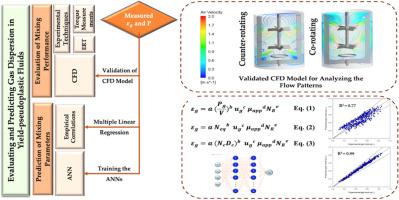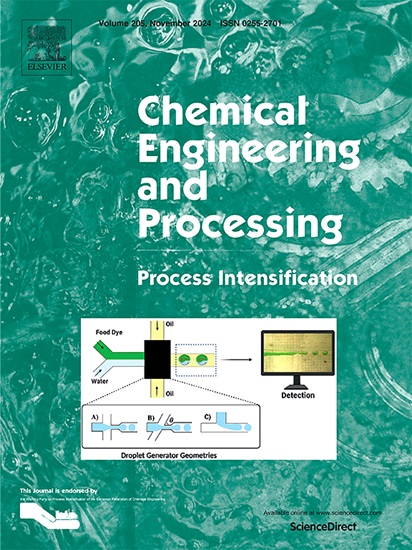全面研究具有屈服应力的剪切稀化流体在双同轴混合器中的气体滞留:实验、数值和人工神经网络方法
IF 3.8
3区 工程技术
Q3 ENERGY & FUELS
Chemical Engineering and Processing - Process Intensification
Pub Date : 2024-11-01
DOI:10.1016/j.cep.2024.110049
引用次数: 0
摘要
这项研究解决了屈服应力非牛顿流体中气体分散不均匀的难题,这种流体在生物制药、化妆品和食品加工等行业中很常见。虽然之前的研究证明了双同轴混合器在处理假塑性流体方面的优势,但对具有较高纵横比的屈服假塑性流体的充气问题关注有限。本研究利用电阻断层扫描和计算流体动力学,对各种条件下的局部和全局气体滞留进行了研究,弥补了这一空白。主要研究结果表明,在 Nc = 350 rpm 和 Qg = 20 L/min 条件下,将锚转速从静止提高到 30 rpm 可显著提高曝气效率(单位功率消耗的气体截留),在 UP-CO 模式下提高 78%,在 UP-COUNTER 模式下提高 25%。这些结果表明,在特定的运行条件下,气体分散得到了加强,从而推动了整体工艺的改进。为确保准确预测气体滞留,我们开发了尺寸和无尺寸经验相关性以及人工神经网络(ANN)模型。人工神经网络模型表现出卓越的准确性,两种旋转模式的 R² 值均达到 0.99,优于经验模型,后者在 UP-CO 和 UP-COUNTER 模式下的 R² 值分别为 0.90 和 0.89。本文章由计算机程序翻译,如有差异,请以英文原文为准。

Comprehensive investigation of gas hold-up in a double coaxial mixer with shear-thinning fluids exhibiting yield stress: Experimental, numerical, and artificial neural network approaches
This study addresses the challenge of uneven gas dispersion in yield-stress, non-Newtonian fluids, commonly encountered in industries such as biopharmaceuticals, cosmetics, and food processing. While previous research demonstrated the advantages of dual coaxial mixers for pseudoplastic fluids, limited attention has been given to aerating yield-pseudoplastic fluids with higher aspect ratios. This study bridges that gap by investigating both local and global gas hold-up under various conditions, utilizing electrical resistance tomography and computational fluid dynamics. Key findings showed that increasing the anchor speed from stationary to 30 rpm significantly enhanced aeration efficiency (gas hold-up per specific power consumption), with improvements of 78 % in UP-CO mode and 25 % in UP-COUNTER mode at Nc = 350 rpm and Qg = 20 L/min. These results underscore enhanced gas dispersion under specific operating conditions, driving overall process intensification. To ensure accurate prediction of gas hold-up, both dimensional and dimensionless empirical correlations, along with an artificial neural networks (ANNs) model, were developed. The ANNs model exhibited superior accuracy, achieving R² values of 0.99 for both rotation modes, outperforming empirical models, which achieved R² values of 0.90 and 0.89 for UP-CO and UP-COUNTER modes, respectively.
求助全文
通过发布文献求助,成功后即可免费获取论文全文。
去求助
来源期刊
CiteScore
7.80
自引率
9.30%
发文量
408
审稿时长
49 days
期刊介绍:
Chemical Engineering and Processing: Process Intensification is intended for practicing researchers in industry and academia, working in the field of Process Engineering and related to the subject of Process Intensification.Articles published in the Journal demonstrate how novel discoveries, developments and theories in the field of Process Engineering and in particular Process Intensification may be used for analysis and design of innovative equipment and processing methods with substantially improved sustainability, efficiency and environmental performance.

 求助内容:
求助内容: 应助结果提醒方式:
应助结果提醒方式:


